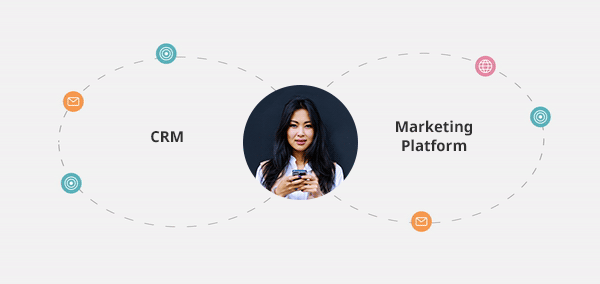Customer Retention: What It Is And How It Helps To Sustain Business
There's no denying that we're in uncertain times. Even though you might feel inclined to focus your efforts on acquisition, you shouldn’t forget about the customers you already have. Let’s explore why customer retention matters for sustaining business now – and in the future.

Get Smart With Your Budget – Acquire Some, Retain More
While acquisition creates a foundation of customers, retention strategies maximise the profitability of each customer. And you want to ensure that the customers you worked hard to acquire stay with you and generate the highest customer lifetime value (CLV) as possible.
Don’t get me wrong: maintaining visibility in your market is critical for long-term profitability and continued investment. But if you’re like most companies: you’re in a position where you need to slice your budget. Correct?
Well, now might be the perfect time to focus a bit extra on retention. Here’s why:
- Existing customers contribute more to overall revenue – 65% of a company’s business, as a matter of fact
- Retention’s more cost-efficient. Acquiring new customers costs 5 to 10 times more than selling to an existing customer
- It’s easier. The probability of selling to a customer is 60-70%, while the probability is 5-20% to a new prospect
- It increases profits. A 5% boost in customer retention leads to 25-95% increase in profits
Heighten Your Profitable Customers’ Lifetime Value
All customers matter. But some matter just a little bit more. The Pareto Principle states that approximately 80% of your revenue stems from 20% of your customers. So, imagine the revenue you’ll generate when you increase engagement, loyalty and the customer lifetime value in the top 20?

A common scoring-method used to analyse customer profitability is RFM (Recency, Frequency, Monetary value). When you’re more aware of customer profitability, you’ll be able to weigh segments against each other and allocate resources to maximise ROI.
Analyse Data To Understand Needs
Customers, leads and prospects have significantly different needs. And your customers have different needs, too. So, if you want your customers to feel that you understand them, you can’t base your marketing on guesswork.
An important ingredient toward mutual understanding is to analyse your customer data to decipher trends and predict needs. Preferably across all channels and customer touchpoints.
But data analysis is no small feat. Even more so if you have multiple tools and platforms for data processing and analysis. The key to turning data analysis from a semi-manual headache to automated ease is to:
- Use one platform for audience activation and analysis
- Gather historical and behavioural data into unique customer profiles
- Equip yourself with a smooth tool for analysis that enables you to gain insights into results and conversions.
Marketing Automation Makes Retention Easy
Let’s not beat around the bush... Marketing automation is the cornerstone of smart customer retention. No blood, no sweat, no tears. Just automated responses based on the actions people take.
Now, the bold words epitomise how you need to communicate with your customers amidst the current situation. With timely communications set in real-time, people feel talked to – rather than with. And with this personal relevance comes a sense of personal understanding that’s critical to retain customers.

The Union of Professional Engineers in Finland (Insinööriliitto) sums it up perfectly in their customer case:
"... serving our members better means that the content needs to be personalised, relevant and sent at the right time. Even though the recipient might not act on it or convert straight away, they need to feel that we understand, and are considerate toward, their situation and their needs."
Now, you can utilise marketing automation for any purpose possible. For customer retention purposes, you can set up onboarding flows, re-engagement flows, and specific date flows for anniversaries or subscription renewals – to name a few!
Improve Your Onboarding to Reduce Early Churn
Did you know that 23% of customers churn due to poor onboarding? Make your customers succeed through an onboarding flow that gives them the tools they need to get started fast and easy. This could be to promote training, a knowledge base, or general tips on how to maximise the usage of a product or service.
But! (there's always a but...)
Just because a user started using your product doesn't mean they'll keep using it. A good user experience comes down to consistency. So, communicate continuously through a company newsletter, targeted campaigns and inspirational content to support users and create upselling opportunities.
Integrate your CRM With Your Marketing Platform
As we know, a CRM-system provides a relational overview of a company's interactions and transactions with current (and potential) customers. Albeit, the system doesn’t, by itself, manage customer retention. But it is a helpful tool to manage activities that take place between marketing and sales.
However…
They are limited in their capabilities. To avoid siloed data, fractured customer views, and out-of-touch customer communication, you should look into Integrating your CRM-system with your marketing platform. Instead of having two distinct systems operating side-by-side, a two-way data integration automatically makes up-to-date customer information flow between the two.
This creates a reality where systems, people and data work in symbiosis. Your sales organisation can gain greater insights and view email and website interactions on the contact card. Marketing can access and use CRM lists to target customers with retention campaigns. And you can even save time by managing your CRM's follow up activities to trigger flows.

Want to discover how Apsis One can help you retain customers? Sign up for our free 14-day Apsis One trial today.